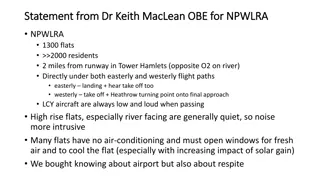Tower Hamlets Economy Overview
Tower Hamlets boasts a thriving economy, with an economic output surpassing major UK cities outside London. The borough experienced significant growth between 2008 and 2017, with a high concentration of small and micro-businesses. It hosts a large number of jobs, particularly in the finance and insurance sector, although the resident workforce earns less than non-residents.
Download Presentation

Please find below an Image/Link to download the presentation.
The content on the website is provided AS IS for your information and personal use only. It may not be sold, licensed, or shared on other websites without obtaining consent from the author.If you encounter any issues during the download, it is possible that the publisher has removed the file from their server.
You are allowed to download the files provided on this website for personal or commercial use, subject to the condition that they are used lawfully. All files are the property of their respective owners.
The content on the website is provided AS IS for your information and personal use only. It may not be sold, licensed, or shared on other websites without obtaining consent from the author.
E N D
Presentation Transcript
Borough Profile 2020 Chapter 3: Economy
Summary Tower Hamlets economic output in 2017 was 29.7bn more than Birmingham or the City of Manchester. The economy grew by 49% between 2008 and 2017. Business growth of 36% in last 5 years. Vast majority (98%) are small and micro businesses. Nearly 300,000 jobs in the borough greater than the working age population and continuing to rise. Finance and Insurance makes up 22% of all jobs, but this figure has fallen by 4% (or 6,000 jobs) since 2015. Most jobs (86%) are filled by non residents. The median earnings of 870 for workers is the 2ndhighest in the UK but residents earn significantly less - 90 per week.
Size of the Tower Hamlets Economy In 2017, Tower Hamlets had a total economic output, or gross value added, of around 29.7 billion higher than any of the core UK cities outside of London. The borough accounted for 7 per cent of the economic output in London and 2 per cent of the economic output in the UK. Between 2008 and 2017, the economy grew by almost 10 billion or 49 per cent. This was faster growth than in London as a whole (41 per cent) and much higher than the UK as a whole (27 per cent). 100.0 Gross Value Added for NUTS 3 Areas, 2008 and 2017 ( bns) 80.0 87.8 60.0 61.2 51.7 40.0 38.6 29.7 28.2 20.0 23.4 23.2 21.0 20.0 19.3 19.3 19.1 17.8 15.5 13.3 - Tower Hamlets City of Camden and City of London City of Manchester 2008 Glasgow Leeds Birmingham Edinburgh Westminster Source: Regional Gross Valued Added (Income Approach), Office For National Statistics, 1997 to 2017 2017
Businesses operating in Tower Hamlets In 2019, there were 17,355 local enterprises based in Tower Hamlets. The number of businesses based in the borough has increased by 36 per cent in the past five years (up from 12,790 enterprises in 2014). This is higher growth than in London as a whole (30%) and higher than Great Britain (20%). 98% are either micro businesses or small businesses (less than 50 employees) Tower Hamlets Tower Hamlets London London Business Size (numbers of enterprises) 15,560 1,385 300 100 17,355 (%) 89.7 8 1.7 0.6 100 (numbers) 473,875 38,570 7,650 2,145 522,240 (%) 90.7 7.4 1.5 0.4 100 Micro (0-9 employees) Small (10-49 employees) Medium (50-249 employees) Large (250+ employees) Total (Source: ONS Interdepartmental Business Register 2019)
Jobs in Tower Hamlets 298,000 jobs and more jobs than working age residents. 22,000 additional jobs between 2015 and 2018 an increase of 8% In the same time period the number of jobs in London increased by 5% and in England by 3.5%. Although the Finance and Insurance industry makes up only 3% of businesses it makes up 22% of all jobs in 2018 with an average of 127 jobs per business. However, the number of jobs within this sector has fallen in 2015 it represented 26% of all jobs. The Health industry also has relatively few large employers averaging 54 jobs per business. Conversely arts, entertainment, recreation and other services accounts for 6.3% of businesses but 2.5% of all employee jobs an average of 7 jobs per business. The construction industry also employs relatively few persons at an average of 7.5 jobs per business. 86% of all jobs are filled by commuters into the borough.
Jobs in Tower Hamlets Employee Jobs and Enterprises by Broad Industry, 2018 6.3% Arts, entertainment, recreation & other services 2.5% 3.0% Health 9.4% 2.1% Education 5.7% 0.0% Public administration & defence 4.0% 9.1% Business administration & support services 11.7% 25.4% Professional, scientific & technical 15.8% 4.2% Property 2.3% 3.0% Financial & insurance 22.1% 19.3% Information & communication 9.1% 5.4% Accommodation & food services 5.7% 2.3% Transport & storage (inc postal) 1.7% 12.1% Wholesale, retail and motortrades 7.8% 4.6% Construction 2.0% 2.6% Manufacturing 1.2% 0.6% Mining, quarrying & utilities 0.0% 0.0% 5.0% 10.0% 15.0% 20.0% 25.0% 30.0% Source: ONS Business Register and Employment Survey 2018 and ONS Annual Population Survey July 2018 to June 2019 Businesses Employee Jobs
Earnings At 870, median earnings for workers in Tower Hamlets are the second highest in the UK (after the City of London). Residents earn around 90 less on average than those working in Tower Hamlets the largest gap between workers and residents in London. The gap between workers and residents narrowed in 2019, due to both a reduction in earnings by place of work and an increase in earnings by place of residence Median Weekly Earnings of Workers and Residents in Tower Hamlets, 2009 - 2019 922 950 901 898 887 900 870 862 862 847 842 833 850 820 780 800 726 750 710 Place of Work 700 665 663 660 Place of Residence 652 650 646 639 635 650 600 Source: ONS Annual Survey of Hours and Earnings, Residence and Workplace Analysis, 2009 - 2019 550 500 2009 2010 2011 2012 2013 2014 2015 2016 2017 2018 2019
Future Growth The GLA project an increase of 110,000 jobs between 2016 and 2026 by far the largest increase in London. 40% increase on the existing number of jobs Geographically, most jobs are expected to be located in Canary Wharf and City Fringe Biggest sectoral increase is professional, scientific and technical (+20%). Projected increase in Employee jobs, 2016 to 2026 (Top 10 London Boroughs) Tower Hamlets 110,000 City of London 66,000 Westminster 47,000 Newham 41,000 Southwark 36,000 Hackney 33,000 Camden 31,000 Despite this growth, there is expected to be a 13% fall in manufacturing jobs. Source: GLA, Labour Market Projections (2017) employee jobs Islington 30,000 Hammersmith and Fulham 16,000 Hillingdon 10,000 *It is important to note that these projections do not take into account the considerable economic impacts of the 2020 Covid 19 Pandemic. - 20,000 40,000 60,000 80,000 100,000 120,000























